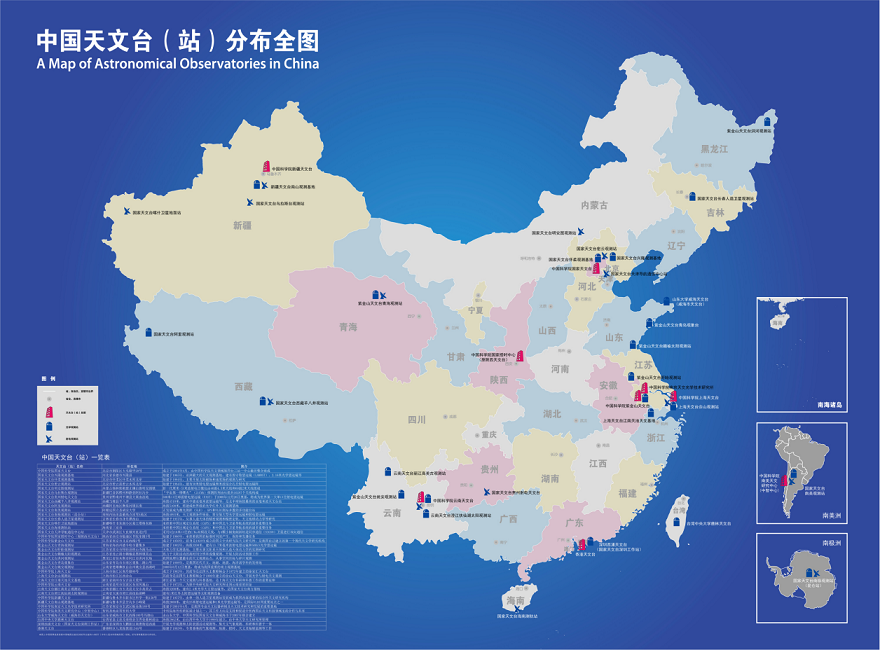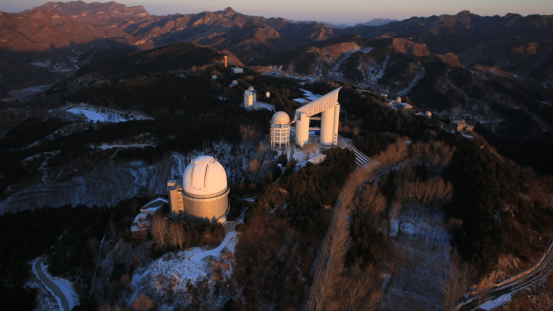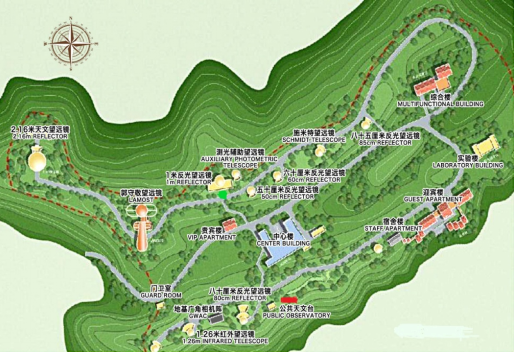The Xinglong Observatory belongs to the National Astronomical Observatories, Chinese Academy of Sciences (NAOC) and the CAS Key Laboratory of Optical Astronomy. It was first surveyed in 1965 and put into use in 1968. After more than half a century of construction, now it is the largest optical astronomical observation base in Asia. The Xinglong Observatory is located at the south foot of the main peak of the Yanshan Mountain in Xinglong County, Hebei Province, with an average altitude of about 900 meters. The geographical coordinates are 117°34’38”E and 40°23’36”N. The geographical location of the Xinglong Observatory base is shown in Figure 1.

Figure 1 the distribution of observatories in China and the geographical location of the Xinglong Observatory
The atmospheric transparency of the Xinglong Observatory is good and the median seeing is 1.8”, and the sky brightness is ~21.1 mag arcsec2 in the V band at the zenith. There are 240 - 260 spectral nights every year, including 100 - 120 photometric observing nights. It has excellent astronomical observation conditions and perfect logistics facilities.
At present, the Xinglong Observatory has several optical astronomical telescopes: 2.16m telescope, 1.26m infrared telescope (Guangzhou University - National Astronomical Observatory Telescope, or GNT), 85CM telescope (National Astronomical Observatories - Beijing Normal University Telescope, or NBT), 80cm telescope (Tsinghua University - National Astronomical Observatories Telescope, or TNT), 60cm telescope, etc. Besides, LAMOST, 1-meter reflective telescope, 60/90cm Schmidt telescope, 50cm reflective telescope, GWAC Sky Survey Telescope and other telescopes are also located here. It has a complete set of high, medium and low -resolution spectrum and high-precision metering and observation equipment, with detection capability covering optical and near-infrared bands. Every year, more than 100 domestic and foreign astronomers use the 2.16m telescope to observe stars, galaxies and celestial bodies in the solar system. The 2.16m telescope has won the first prize of National Science and Technology Progress, which is regarded as a milestone in the history of Chinese astronomy. Based on the 2.16m telescope and other equipment of the Xinglong Observatory, astronomers have obtained several important research achievements, including a second prize of the National Natural Science Award. Many papers have been published in the top academic journals such as Nature, and many achievements have been selected into the top ten astronomical scientific and technological progress of the year and play an important role in the international joint survey. Meanwhile, the Xinglong Observatory is also a national science outreach and education base of China for training students from graduate schools, colleges, high schools, and other educational institutions throughout China, and it has hosted many international workshops and summer schools. The research and development, and talent training base are gradually becoming a high-level research and education base. The panorama and map of the Xinglong Observatory are shown in Fig. 2 and Fig. 3.

Figure 2 panorama of the Xinglong Observatory

Figure 3 map of the Xinglong Observatory
While serving the development of scientific research, the base actively promotes the "integration of science and education" and the popularization of science among the whole people, striving to improve the public's astronomy literacy, and has carried out a variety of public open activities, which have won high praise from all walks of life. It has built 80cm, 85cm and 1.26m telescopes with Tsinghua University, Beijing Normal University and Guangzhou University respectively. As the student practice base of more than ten universities such as Peking University, Beijing Normal University, Shandong University and Hebei Normal University, it receives more than 300 internships and joint training of graduate students every year and receives more than 10000 public visits each year. The Xinglong Observatory was twice selected as the "National Popular Science and Education Base" (2010-2014 and 2015-2019) and was listed as "Beijing University municipal off-campus talent training base" and "Hebei Normal University astronomy practice base".
The Xinglong Observatory is about 150km away from Beijing, and it takes about 2.5 hours by bus. There are shuttles to and from the headquarters of the National Astronomical Observatory and the Xinglong Observatory every Tuesday and Friday. The transportation is convenient, and the living facilities are perfect. In addition to convenient transportation, the observatory also has a restaurant (see Figure 4, left), which can provide catering services for nearly 100 people at the same time. The restaurant mainly provides breakfast, lunch and dinner service, and the food supply is of high quality and low price, which is highly praised by the base staff, observers and visitors. The observatory has 4 Apartments (reception building, comprehensive building, dormitory building, VIP Building) and a office building (center building). In addition to meeting the accommodation and office needs of the base staff and observers, it can also undertake the visiting practice and conference activities of about 100 people. Fig. 4, right and Fig. 5 shows the environment of two of the apartments - the welcome building and the dormitory building, and the conference room of the central building. Also, to maintain a good environment of the base, the observatory has special personnel responsible for the sanitation, greening, fire prevention and facilities maintenance of the park.

Figure 4 left: restaurant of the Xinglong Observatory; right: conference room of the Xinglong Observatory

Fig. 5: the left picture shows the accommodation apartment of the Xinglong Observatory (the nearest is Yingbin building, and the middle is the dormitory building); the right picture is the interior view of the Yingbin building of the Xinglong Observatory

Address: 20A Datun Road, Chaoyang District, Beijing, China code: 100012
Tel: 010-64888708 E-mail: naoc@nao.cas.cn

